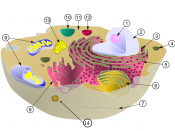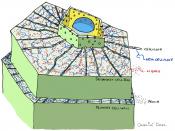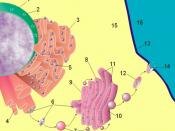Eukaryotic Cell vs. Prokaryotic Essay
A eukaryotic plant cell consists of many organelles, a cell wall, and a nucleus. Unlike an animal cell, plant cells have cell walls that allow them to bind to other plant cells, hold their structure, and prevent excessive water intake. Young plant cells have a primary cell wall, which is thin and fairly flexible. Between the primary cell walls is the middle lamella, which sticks the cell walls together. As the cell matures, it either secretes hardening substances into the primary wall, or develops a second, stronger wall, called the secondary cell wall, which develops between the plasma membrane and the primary cell wall.
Cytoskeleton also provides structural support for the cell. This versatile structure can move around the cell, altering its shape. The cytoskeleton also helps with the transportation of vesicles around the cell. The cytoskeleton is made up of three types of fibers: microtubules, microfilaments, and intermediate filaments.
Microtubules appear as rods in a cell, they provide structural support. Microfilaments, built from the globular protein actin, help support a cell's shape and cell motility, such as in muscle cells.
Mitochondria are the sites for cell respiration. Respiration is the process of generating ATP from sugars and fats. Chloroplasts, which are only found in plant cells, are the sites of photosynthesis, the conversion of solar energy to chemical energy by absorbing sunlight and synthesizing organic compounds from carbon dioxide and water.
Mitochondria is enclosed in an envelope of two membranes, each a phospholipid bilayer with embedded proteins. The inner folds of a mitochondria are called cristae. The second compartment of a mitochondria is the mitochondrial matrix, where many enzymes are concentrated.
In a chloroplast, there are two membranes separated by a thin intermembrane space. Inside the membranous system of a chloroplast, there are flattened...


